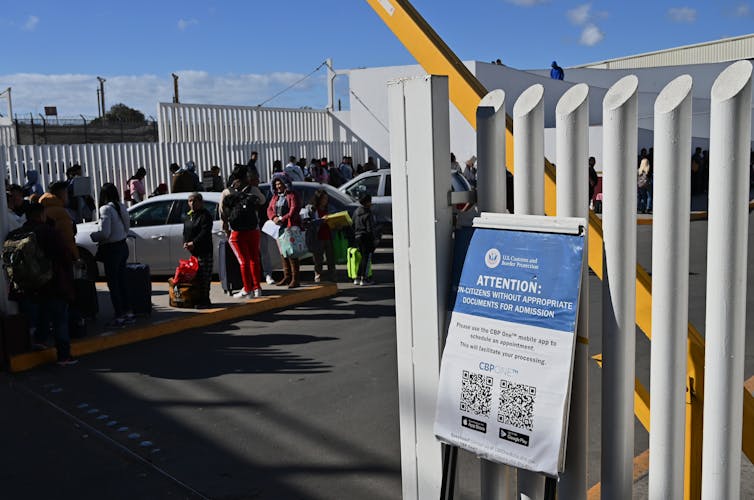
Simulating eXtreme Spacetimes Lensing (SXS), CC BY-SA
Marco Ajello, Clemson University and Jonathan Zrake, Clemson University
Every galaxy has a supermassive black hole at its center, much like every egg has a yolk. But sometimes, hens lay eggs with two yolks. In a similar way, astrophysicists like us who study supermassive black holes expect to find binary systems – two supermassive black holes orbiting each other – at the hearts of some galaxies.
Black holes are regions of space where gravity is so strong that not even light can escape from their vicinity. They form when the core of a massive star collapses on itself, and they act as cosmic vacuum cleaners. Supermassive black holes have a mass a million times that of our Sun or larger. Scientists like us study them to understand how gravity works and how galaxies form.
Figuring out whether a galaxy has one or two black holes in its center isn’t as easy as cracking an egg and examining the yolk. But measuring how often these binary supermassive black holes form can help researchers understand what happens to galaxies when they merge.
In a new study, our team dug through historical astronomical data dating back over a hundred years. We looked for light emitted from one galaxy that showed signs of harboring a binary supermassive black hole system.
Galactic collisions and gravitational waves
Galaxies like the Milky Way are nearly as old as the universe. Sometimes, they collide with other galaxies, which can lead to the galaxies merging and forming a larger, more massive galaxy.
The two black holes at the center of the two merging galaxies may, when close enough, form a pair bound by gravity. This pair may live for up to hundreds of millions of years before the two black holes eventually merge into one.

Binary black holes release energy in the form of gravitational waves – ripples in space-time that specialized observatories can detect. According to Einstein’s general relativity theory, these ripples travel at the speed of light, causing space itself to stretch and squeeze around them, kind of like a wave.
Pulsar timing arrays use pulsars, which are the dense, bright cores of collapsed stars. Pulsars spin very fast. Researchers can look for gaps and anomalies in the pattern of radio waves emitted from these spinning pulsars to detect gravitational waves.
While pulsar timing arrays can detect the collective gravitational wave signal from the ensemble of binaries within the past 9 billion years, they’re not yet sensitive enough to detect the gravitational wave signal from a single binary system in one galaxy. And even the most powerful telescopes can’t image these binary black holes directly. So, astronomers have to use clever indirect methods to figure out whether a galaxy has a binary supermassive black hole in its center.
Searching for signs of binary black holes
One type of indirect method involves searching for periodic signals from the centers of active galaxies. These are galaxies that emit significantly more energy than astronomers might expect from the amount of stars, gas and dust they contain.
These galaxies emit energy from their nucleus, or center – called the active galactic nucleus. In a process called accretion, the black hole in each active galaxy uses gravity to pull nearby gas inward. The gas speeds up as it approaches the black hole’s event horizon – like how water surrounding a whirlpool moves faster and faster as it spirals inward.
As the gas heats up, it glows brightly in optical, ultraviolet and X-ray light. Active galactic nuclei are some of the most luminous objects in the universe.
Some active galactic nuclei can launch jets, which are particle beams accelerated to near the speed of light. When these jets line up with our observatories’ lines of sight, they appear extremely bright. They’re like cosmic lighthouses.
Some active galactic nuclei have periodic light signals that get bright, fade and then get bright again. This unique signal could come from the cyclical motion of two supermassive black holes inside, and it suggests to astronomers to look for a binary black hole system in that galaxy.
On the hunt for a binary black hole system
Our team studied one such active galactic nucleus, called PG 1553+153. The light from this object gets brighter and dimmer about every 2.2 years.
These periodic variations suggest that PG 1553+153 has a supermassive black hole binary inside. But a binary isn’t the only explanation for this variation. Other phenomena, such as wobbly jets or changes in the flow of material around the black hole, could also explain this pattern without the presence of a binary black hole, so we had to rule those out.
To understand whether the PG 1553+153 system’s light emission patterns came from a binary black hole, we simulated how binary supermassive black holes collect gas. Our models suggested that sometimes, when the black holes pull in gas, dense clumps of gas collect around the outside of the hole.
We calculated that the time it takes for these clumps to orbit around the two black holes should be five to 10 times longer than the time it takes for the two black holes to circle each other.
So, we finally had a clear prediction that we could test. If a binary black hole system caused the 2.2-year periodic variation in PG 1553+153, then we should also be able to see a longer pattern of variation, about every 10 to 20 years, when the clumps of gas circle around the black holes.
But to see whether this was really a pattern, we needed to watch it repeat for four to five cycles. For PG 1553+153, that would be 40 to 100 years.
Astronomers have observed the sky for hundreds of years. But the era of digital astronomy, where astronomical images are recorded on computers and saved in databases, is very recent – only since the year 2000 or so.
Before then, starting around 1850, astronomers recorded images of the sky on photographic plates. These are flat pieces of glass coated with a light-sensitive chemical layer traditionally used in photography. Many observatories around the world have photographic images of the night sky dating back to more than a hundred years ago. Before that, astronomers would sketch what the sky looked like in their notebooks.
Projects like DASCH, Digital Access to a Sky Century at Harvard, have started digitalizing photographic plates from a few observatories to make them available for scientists and nonscientists alike.
Our team learned that the DASCH database provided data on PG 1553+153 dating back to 1900 – more than 120 years. We used this dataset to see whether we could see a pattern repeating every 10 to 20 years.
Somewhat to our surprise, we found a 20-year pattern that adds more evidence to our theory that there’s a binary system at the core of PG 1553+153. The detection of this second pattern also helped us figure out that the masses of the two supermassive black holes are in a 2.5:1 ratio – with one 2½ times as large as the other – and that their orbit is nearly circular.
While this historical data makes us more confident that there are two supermassive black holes in PG 1553+153, we still can’t say for sure. The final confirmation might need to wait until pulsar timing arrays become sensitive enough to detect the gravitational waves coming from PG 1553+153.![]()
Marco Ajello, Professor of Physics and Astronomy, Clemson University and Jonathan Zrake, Assistant Professor of Physics, Clemson University
This article is republished from The Conversation under a Creative Commons license. Read the original article.














































